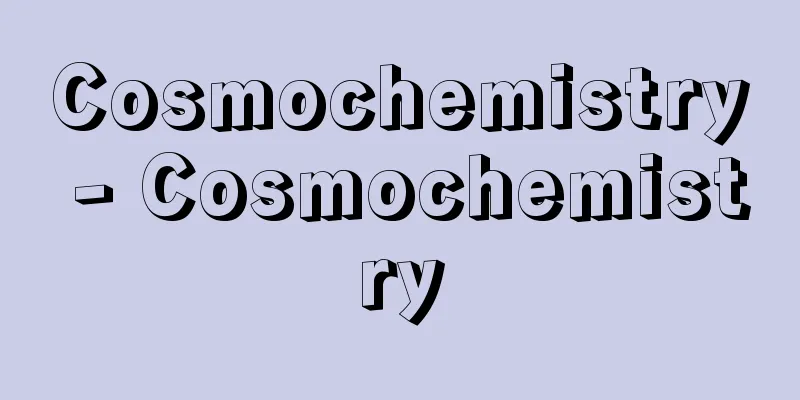Cosmochemistry - Cosmochemistry

|
A branch of chemistry that seeks to understand various celestial bodies, including the Earth, that is, materials that exist in the universe, from a chemical perspective and method. In this case, since it is not always possible to directly and freely pick up the target material, except on Earth, it may be necessary to leave the Earth and reach outer space to collect samples. Therefore, the chemistry of artificial satellites and other tools used for such purposes is sometimes included in space chemistry. However, since the usual aim is to study the distribution, generation, and annihilation processes of elements in the universe, and to elucidate how the universe develops and unfolds chemically, it is closely related to nuclear chemistry. The elementary particles that are believed to be the source of matter currently known include neutrons, protons, mesons, and electrons, and it is beginning to become clear how these combined to help create the universe. First, the Milky Way separated, and hydrogen was burned by nuclear fusion to produce helium, which became the first generation. This then prompted the appearance of giant stars G, which burned helium to produce carbon, which then led to the appearance of supernovae, which became white dwarfs, and finally the appearance of the second generation, which led to the formation of the Sun. All reactions in the universe, including elemental transformations and reactions on the Sun, are the subject of astrochemistry. Currently, it is difficult for chemists to obtain materials outside the solar system, but meteorites and space dust (interstellar matter) can be obtained within the solar system. Furthermore, it has become possible to explore the moon and planets by spacecraft, and to obtain other materials outside the Earth, and many things have been revealed from these. Furthermore, knowledge of the Milky Way and interstellar matter has increased through spectroscopic research of various electromagnetic waves. [Nakahara Katsunori] "Naoki Onuma, Space Chemistry - The Primitive Solar System as Seen from Chondrites (1987, Science House)" ▽ "Naoki Onuma, Fascinated by Space Chemistry and Geochemistry (1991, Science House)" ▽ "Masaru Nishikawa, editor, Modern Chemistry Outlook - From Atoms to the Universe (1997, Baifukan)" ▽ "Masako Shima, Meteorites - A Gift from Space (1998, Tokyo Kagaku Dojin)" [References] | | | | | | | | | | | | | | | | | | |Source: Shogakukan Encyclopedia Nipponica About Encyclopedia Nipponica Information | Legend |
|
地球を含めて各種の天体物質、つまり宇宙に存在する物質を化学的な見方や方法で解明しようとする化学の一分野。この場合、地球を除いては、対象物質を直接自由に取り上げることができるとは限らないので、地球から離れ、宇宙空間に到達して試料を採取する必要も生ずることがある。したがって、そのような手段に使う人工衛星その他についての化学をも宇宙化学に含めることもある。しかし普通には、宇宙における元素の分布、発生あるいは消滅などの過程を研究し、宇宙が化学的にどのように発展し、展開していくかということを解明することを目的とするので、核化学ときわめて密接な関係がある。 物質の根源とされている素粒子には、現在わかっているものとして、中性子、陽子、中間子、電子などがあり、これらがどのような組合せで宇宙の生成に役だってきたかが明らかになってきている。 初めに銀河系が分離し、水素が核融合によって燃焼してヘリウムができ、第1世代となった。そしてこれが巨星Gの出現を促し、ヘリウムが燃焼して炭素となり、超新星が出現し、白色矮星(わいせい)となり、第2世代が出現してようやく太陽ができた。この間の元素転換や太陽での反応など、宇宙空間すべての反応が宇宙化学の対象となっている。現在化学者には太陽系以外の物質を手に入れることは困難であるが、太陽系内では隕石(いんせき)、宇宙塵(じん)(星間物質)などは手に入れることができる。さらには宇宙船による月探査、惑星探査、そのほか地球外の物質の入手も可能となり、これらから多くのことが明らかにされてきている。また各種電磁波の分光学的研究から銀河系や星間物質などの知識も増してきている。 [中原勝儼] 『小沼直樹著『宇宙化学――コンドライトから見た原始太陽系』(1987・サイエンスハウス)』▽『小沼直樹著『宇宙化学・地球化学に魅せられて』(1991・サイエンスハウス)』▽『西川勝編著『現代化学展望――原子から宇宙まで』(1997・培風館)』▽『島正子著『隕石――宇宙からの贈りもの』(1998・東京化学同人)』 [参照項目] | | | | | | | | | | | | | | | | | | |出典 小学館 日本大百科全書(ニッポニカ)日本大百科全書(ニッポニカ)について 情報 | 凡例 |
<<: Institute of Space and Astronautical Science
>>: Cosmogony - uchuukaibyakusetsu (English spelling)
Recommend
Traetta, T. (English spelling)
… In the 1730s, music began to be directly import...
Viscosity Index - Nendoshisu
A scale showing the rate at which the viscosity of...
Dinichthys (English spelling)
A large fish that lived in the Paleozoic Era, belo...
Classical School of Political Economy
Liberal economics, as taught by people from Smith ...
Takajo [town] - Takajo
A former town in Kitamorokata District, southern M...
Tyler, E. (English spelling) TylerE
...However, the movement quickly died down when f...
Hilarius (of Poitiers)
315 koro-367 Father of the Western Church. Born in...
Prescriptive grammar - normative grammar; prescriptive grammar
Prescriptive grammar is made up of rules that dete...
Emergency medical system
...After that, emergency medical centers with adv...
fes
…A cylindrical hat made of red felt with small ta...
"Kanjin Gaku Shoki"
…On the other hand, together with his disciple Ni...
GARIOA - Garioa
Government Appropriation for Relief in Occupied Ar...
Eisgruber, E.
...This was a time when cheap German lithographs ...
Violence - violence
Generally, in the political world, physical force...
Jisho-Juei Civil War
A nationwide civil war that took place from 1180 (...









